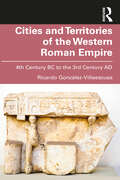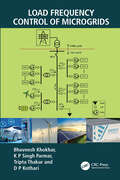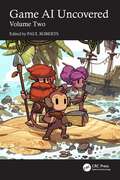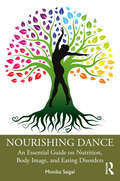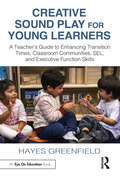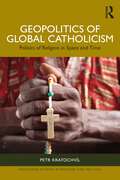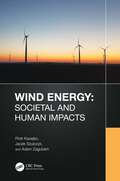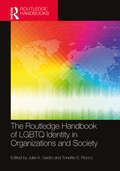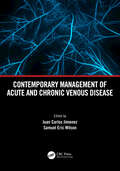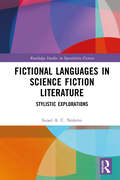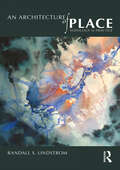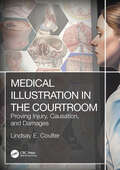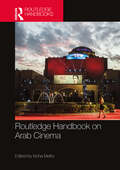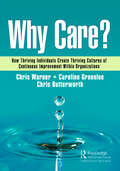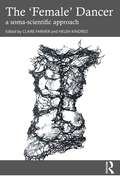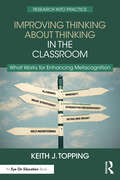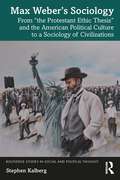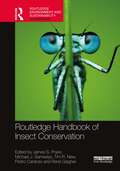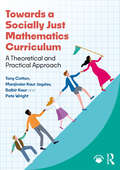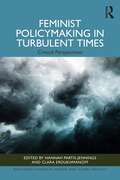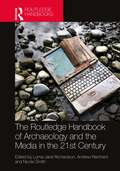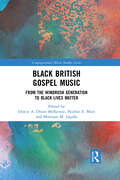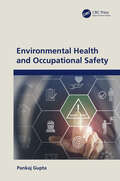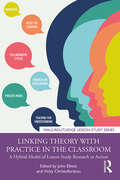- Table View
- List View
Cities and Territories of the Western Roman Empire: 4th Century BC to the 3rd Century AD
by Ricardo González-VillaescusaThis book showcases the unique shape of urban development that took hold during the Roman Empire, beginning in the Mediterranean basin before spreading out across Europe, and offers a fresh perspective on the cities and territories of the Roman West.With the expansion of Rome came a particular form of social organisation: the Roman city. This book provides a basic introduction to Roman cities, not through the lens of architecture and urbanism, but from a social, legal, cultural, spatial, and functional perspective. It focuses on the Roman civitas – the city and its territory – as the spatial model par excellence of Roman colonialism and expansion. Exploring primarily the cities and territories of the Western Empire, such as the Iberian Peninsula, Gaul, and Britain, González-Villaescusa revives from their ruins those central places that facilitated the circulation of people, goods, and information, forming the large urban network of a unified imperial territory.Cities and Territories of the Western Roman Empire: 4th Century BC to the 3rd Century AD is suitable for school and university students, as well as the general reader interested in the subject of Roman cities in the Western Empire.
Load Frequency Control of Microgrids
by D P Kothari Bhuvnesh Khokhar K P Parmar Tripta ThakurThe book focuses on describing the emerging microgrid concept, and its various constituents, especially the EV technology, and investigates the load frequency control performance of different microgrid configurations by implementing the modern control theory. An exhaustive study is presented on the various renewable energy sources and an up-to-date status of their installed capacity and power generation. The text presents case studies for load frequency control of a microgrid in its various operating modes.This book: Discusses power system stability, significance of load frequency control in power system, modeling of a microgrid, and frequency deviation response. Covers various energy storage technologies such as superconducting magnetic energy storage, electrochemical energy storage, and compressed air energy storage. Presents modes of interaction of the electric vehicles with the utility grid and implementation of the electric vehicles for load frequency control. Illustrates control approaches for load frequency control and metaheuristic optimization algorithms. Showcases the study of load frequency control for standalone microgrid systems, grid-connected microgrid systems, and multi-microgrid systems. It is primarily written for senior undergraduates, and graduate students in the fields of electrical engineering, electronics, communication engineering, and renewable energy.
Game AI Uncovered: Volume Two
by Paul Roberts Nicholas DentGame AI Uncovered: Volume Two continues the series with the collected wisdom, ideas, tricks and cutting‑edge techniques from 22 of the top game AI professionals and researchers from around the world.The techniques discussed in these pages cover the underlying development of a wide array of published titles, including The Survivalists, Wheelman, Plants vs. Zombies: Battle for Neighborville, Dead Space, Zombie Army 4, Evil Genius 2, Sniper Elite 5, Sonic & All‑Stars Racing Transformed, DiRT: Showdown, and more.Contained within this volume are overviews and insights covering a host of different areas within game AI, including generalised planners, player imitation, awareness, dynamic behaviour trees, decision‑making architectures, agent learning for automated playthroughs, utility systems, machine learning for cinematography, directed acyclic graphs, environment steering, difficulty scenarios, environmental cues through voxels, automated testing approaches, dumbing down your AI, synchronized path following, and much more.Beginners to the area of game AI, along with professional developers, will find a wealth of knowledge that will not only help in the development of your own games but also spark ideas for new approaches.This volume includes chapters written by Nuno Vicente Barreto, Steve Bilton, Andy Brown, Dr Allan Bruce, Richard Bull, Phil Carlisle, Sarah Cook, Michele Condò, Steven Dalton, Rodolfo Fava, Jonas Gillberg, Dominik Gotojuch, Dale Green, Tobias Karlsson, Jonathan Keslake, Fernando Penousal Machado, Ivan Mateev, Dr Nic Melder, Dr Bram Ridder, Paul Roberts, Licínio Roque, and Andrea Schiel.
Nourishing Dance: An Essential Guide on Nutrition, Body Image, and Eating Disorders
by Monika SaigalNourishing Dance: An Essential Guide on Nutrition, Body Image, and Eating Disorders is written with an insider’s understanding of the unique needs and pressures of the dance world and the expertise of an eating disorder specialist, dietitian, clinician, and educator. This much-needed resource provides research-based, practical approaches to help dancers fuel optimally, nourish a peaceful relationship with food, and nurture more positive and resilient body image.Under-fueling, body dissatisfaction, eating disorders, and disordered eating are far too common among dancers. Despite the prevalence of these issues in dancers across genres, and their negative impacts on dancers’ physical and mental health and performance, they have not been adequately addressed in the dance community. Improving dancers’ health and well-being is necessary for both dancers and the art form to thrive, and everyone involved in the training and care of dancers can play an important role in this mission.Nourishing Dance provides essential information on nutrition, body image, and eating disorder prevention to help parents, teachers, staff, choreographers, leadership, athletic trainers, coaches, and healthcare professionals contribute to making the dance world a healthier and safer place for dancers.
Creative Sound Play for Young Learners: A Teacher’s Guide to Enhancing Transition Times, Classroom Communities, SEL, and Executive Function Skills
by Hayes GreenfieldThis fun and engaging guide invites you to use sound-making as a collaborative, play-based practice in your early childhood classroom—first to transform tricky transition times and ultimately to support your children’s executive functioning development and social-emotional learning. The book offers techniques and ideas for every teacher to reach every child in their classroom including verbal, nonverbal, and special needs children. Easy to integrate into all standard early years curricula, it focuses on three basic elements of sound: pitch, volume, and duration. The book features an "overview of the school year" calendar and an implementation guide, in addition to a variety of suggested sound-making activities that start out simply and, through the course of the book, expand to engage children’s creativity in more dynamic ways. Creative Sound Play for Young Learners is key reading for any preschool teacher, leader, or parent.
Geopolitics of Global Catholicism: Politics of Religion in Space and Time (Routledge Studies in Religion and Politics)
by Petr KratochvílGeopolitics of Global Catholicism uncovers the key trends in today’s Catholicism, providing an incisive analysis of its deep entanglement with national, regional, as well as global politics.This book offers an exciting exploration of five versions of local Catholicism(s) and sheds light on the various theo-political constellations that not only differ widely across these national contexts but also have global geopolitical consequences. It is built around a novel theoretical argument showing that Catholic geopolitics contains not only a spatial dimension (as classic geopolitical studies would have it) but also a temporal one. As a consequence, the Catholic role in the world cannot be simply understood as a result of the spatial expansion of the Church but rather as a result of the complex relationships between Catholicism and colonization, inculturation, backwardness, and modernization(s). To counter the lingering Eurocentrism of most studies of the Catholic Church, this book’s case studies explore Catholic geopolitics in five non-European contexts, focusing mainly on the Global South (plus the United States): Latin America (Brazil), North America (the United States), Asia (India and China), and Africa (the Democratic Republic of the Congo). These case studies also show that the successes and failures of Catholicism cannot be explained by a recourse to a single, top-down interpretation of Catholic geopolitics, but rather by exploring the various Catholic spatio-temporal constellations on the global, regional, and local levels. With the accelerating diversification of the Church and the growing role of the Global South, these local and regional influences gain further importance as they are likely to increasingly define the future of Catholicism.This book will be of utmost interest to scholars of International Relations, Religious Studies, Political Science, and Theology, as well as Geopolitics, especially to those studying the global rise of religion. Its accessible language will also appeal to the wider public beyond academia, especially those interested in global Christianity, as well as church leaders, and members of Catholic organizations.
Wind Energy: Societal and Human Impacts
by Piotr Kacejko Jacek Szulczyk Adam ZagubieńWind Energy: Societal and Human Impacts presents the theoretical basis for the various impacts of wind turbines on humans. These impacts include noise (in the audible, low-frequency and infrasound ranges), visual effects (shadow flicker and light reflections), electromagnetic fields, vibrations and oscillations from wind turbines, as well as mechanical impacts and physical risk related to turbine collapse or turbine component failure, throwing of ice or blade parts, fires, etc. Further, this book examines the legal framework, policy approaches and investment processes in the wind energy sector. It addresses the issue of siting and minimum distances between turbines and residential buildings and proposes modifications to legislation, as well as guidelines and recommendations related to environmental impact reports for wind farms, assessment of such reports, monitoring of such impacts and the performance of a post-implementation analysis.
The Routledge Handbook of LGBTQ Identity in Organizations and Society (Routledge International Handbooks)
by Tonette S. Rocco Julie A. GedroSexuality, gender, gender identity, and gender expression are fluid constructs, and the ways in which identity development intersects with organizations and exists in society are complex. The book is comprised of a range of multi-disciplinary and globally inspired perspectives representing leading-edge scholarship by authors from over a dozen countries on a range of issues and contexts regarding LGBTQ identity and experience. It is intended for a wide readership: those who are in LGBTQ-related academic fields; those who want to broaden their coursework by offering supplemental readings that center the perspectives of LGBTQ identities; and those who want to acquire knowledge and education on the subject of LGBTQ identity. There are 36 chapters written by scholars in fields such as social work, law, queer studies, business, human resource management and development, entrepreneurship, criminal justice, economics, marketing, religion, architecture, sport, theater, psychology, human ecology, and adult education. The chapters can be read in sequence, and the book can also be used as a reference work for which educators, practitioners, and non-academics can identify and select particular chapters that inform areas of inquiry.
Contemporary Management of Acute and Chronic Venous Disease
by Samuel Eric Wilson Juan Carlos JimenezWith a focus on evidence-based, contemporary, and clinically relevant information, this practical new resource provides a concise, clinical, and techniques-focused guide to the medical, endovenous, and surgical management of patients with acute and chronic venous disease.Internationally recognized chapter authors cover the general principles of the pathophysiology, diagnosis, indications, and decision-making around the management of acute and chronic venous disease. The text emphasizes endovenous and surgical techniques where applicable, and also addresses symptomatic peripheral venous insufficiency, deep venous thrombosis, and the care of patients with symptomatic central venous disease.Vascular surgeons will find this a valuable guide, providing insights into key techniques and approaches to the treatment of acute and chronic venous disorders. This book is an invaluable resource for vascular trainees preparing for examinations and for physicians in other specialities looking to expand their knowledge base.
Fictional Languages in Science Fiction Literature: Stylistic Explorations (Routledge Studies in Speculative Fiction)
by Israel A. NolettoFictional Languages in Science Fiction Literature surveys a large number of fictional languages, those created as part of a literary world, to present a multifaceted account of the literary phenomenon of glossopoesis (language invention). Consisting of a few untranslated sentences, exotic names, or even fully-fledged languages with detailed grammar and vocabulary, fictional languages have been a common element of English-language fiction since Thomas More’s Utopia (1516).Different notions of the functions of such fictional languages in narrative have been proposed: as rooted in phonaesthetics and contextual features, or as being used for characterisation and construction of alterity. Framed within stylistics and informed by narrative theory, literary theory, literary pragmatics, and semiotics, this study combines previous typologies into a new 5-part reading model comprising unique analytical approaches tailored to science fiction’s specific discourse and style, exploring the relationship between glossopoesis, world-building, storytelling, interpretation, and rhetoric, both in prose and paratexts.
An Architecture of Place: Topology in Practice
by Randall S. LindstromChallenging mainstream architecture’s understandings of place, this book offers an illuminating clarification that allows the idea’s centrality, in all aspects of everyday design thinking, to be rediscovered or considered for the first time.Rigorous but not dense, practical but not trivialising, the book unfolds on three fronts. First, it clearly frames the pertinent aspects of topology—the philosophy of place—importantly differentiating two concepts that architecture regularly conflates: place and space. Second, it rejects the ubiquitous notion that architecture “makes place” and, instead, reasons that place is what makes architecture and the built environment possible; that place “calls” for and to architecture; and that architecture is thus invited to “listen” and respond. Finally, it turns to the matter of designing responses that result not just in more places of architecture (demanding little of design), nor merely in architecture with some “sense of place” (demanding little more), but, rising above those, responses that constitute an architecture of place (demanding the greatest vigilance but offering the utmost freedom).Opening up a term regarded as so common that its meaning is seldom considered, the author reveals the actual depth and richness of place, its innateness to architecture, and its essentiality to practitioners, clients, educators, and students—including those in all spatial disciplines.
Medical Illustration in the Courtroom: Proving Injury, Causation, and Damages
by Lindsay E. CoulterMedical Illustration in the Courtroom: Proving Injury, Causation, and Damages educates the reader on how to communicate science visually—in personal injury, medical malpractice, criminal, and forensic cases—by creating art that utilizes medical records, radiographs, and computer software. Medical illustration bridges the gap between complex technical, medical, and scientific concepts to clearly illustrate, and explain visually, a medical condition, negligence, or the causation of an injury or death to the lay person. Medical artists are frequently challenged with illustrating injuries and medical conditions that can’t be seen by the naked eye. And while using medical photography and imaging for illustrative purposes can be helpful, to an untrained eye it can often be unclear or confusing. This is where the medical illustrator enters the equation. There are often patients who have recovered from an injury or infection that appear in good health. However, should an unforeseen injury or fatality happen, medical illustrators can reveal to people what’s actually going on inside the person, an invaluable asset to attorneys in the courtroom—especially for personal injury and medical malpractice cases. While many attorneys utilize medical artists, nonvisual people don’t always recognize the value of demonstrative aids until they see them first-hand.When attorneys and their clients enlist the aid of medical artists, it quickly becomes apparent that properly conceived and executed artwork is invaluable to illustrating the facts—and medical impacts—of any number of scenarios: homicides by shooting, stabbings, vehicular accidents, in addition to medical malpractice and personal injuries resulting from surgery or possible negligence.Presenting a myriad of services and computer technologies that can be utilized, Medical Illustration in the Courtroom provides demonstrative aids used in cases to illustrate personal injury and medical malpractice, employing "tricks of the trade" to create an accurate effective image. Such images are educational to attorneys, insurance adjusters, judges, and juries to help create a visual storyline, the goal being to help combine art and science to provide a clear illustration of events to help in adjudicate legal and forensic cases.
Routledge Handbook on Arab Cinema
by Noha MellorBuilding on a growing body of literature, this Handbook provides an up-to-date and authoritative survey of Arab cinema.The collection includes contributions from academics and filmmakers from across the Arab region, Europe, and North America, and fills a gap in media studies by examining the entire Arab region, rather than focusing on one country or theme. The Handbook also sheds light on the heterogeneity of Arab filmmaking not only within the Arab region, but also globally, within diasporic communities. It is split into six parts: Part 1 provides an overview of each sub-region in the Arab world, including a chapter on Arab animation films. Parts 2, 3, and 4 address topical themes, encompassing the representation of gender, religion, and identity politics in Arab cinema. Part 5 discusses the theme of diaspora and Part 6 concludes the volume with reflective essays penned by selected diasporic filmmakers. This book is an essential reference for Arab media and cinema scholars, students, and professional filmmakers. With case studies from across the Arab region, it's also a valuable resource for anyone interested in film and media, global cinema, and the Middle East generally.
College 101: A Girl's Guide To Freshman Year (rev. Ed. )
by Julie Zeilinger Anna KoppelmanCollege 101: A Girl's Guide to Freshman Year is a comprehensive and authentic guide for girls to everything college from girls who just went through it!Combining honest, humorous, and relatable first-person perspectives with expert advice, this dynamic guide shows girls what to really expect from their first year of college, including pro tips and common pitfalls to avoid. From managing academics and navigating new social situations, to avoiding debt and getting enough sleep, this book honestly answers all your questions about university life, including those you didn't even know you had!Full of valuable information and must-know secrets about freshman year, College 101 is a must-read for girls who want not only to survive but also actually enjoy their first college experience.
Why Care?: How Thriving Individuals Create Thriving Cultures of Continuous Improvement Within Organizations
by Chris Butterworth Chris Warner Caroline GreenleeWe live in an ever-changing world in which organizations find it increasingly difficult to stay ahead of the changes needed to be successful without thriving people. The authors believe that when people are valued and respected it improves their overall mental well-being and workplace experience, which in turn, makes them more motivated to help meet the purpose and objectives of the organization and adapt to external drivers.This book explores how mental well-being and a culture of continuous improvement are intertwined and mutually reinforcing. The authors contend that to create a sustainable culture of continuous improvement there must be an organization-wide focus on mental well-being at the individual level. A culture of continuous improvement nurtured in the right way, however, will indeed support mental well-being and help create a thriving organization.The key benefit of the book is demonstrating how important mental well-being is for sustainable organizational success. It explores this through many different lenses such as the individual, teams, leaders, and the organization as a whole, and explains the key elements needed for success. Leaders at all levels are able to understand why mental well-being is critical and how to nurture it in the workplace.In addition, the book explains the importance of diversity, equality, inclusion, and belonging, and how this is integral to mental well-being and a thriving organization. This book provides unique insight into how mental well-being and a culture of continuous improvement are intertwined explaining how thriving people and a thriving culture of continuous improvement create a thriving organization.
The 'Female' Dancer: a soma-scientific approach
by Claire Farmer Helen KindredThe 'Female' Dancer aims to question dancers’ relationships with ‘female’ through the examination and understandings of biological, anatomical, scientific, and self-social identity. The volume gathers voices of dance scientists, dance scholars, somatic practitioners, and dance artist-educators, to discuss some of the complexities of identities, assumptions and perceptions of a female dancing body in an intersectional and practically focused manner.The book weaves a journey between scientific and somatic approaches to dance and to dancing. Part I: 'Bodily Knowledge' explores body image, hormones and puberty, and discussions around somatic responses to the concept of the gaze. Part II: 'Moving through Change', continues to look at strength, musculature, and female fragility, with chapters interrogating practice around strength training, the dancer as an athlete, the role of fascia, the pelvic floor, pregnancy and post-partum experiences and eco-somatic perceptions of feminine. In 'Taking up Space', Part III, chapters focus on social-cultural and political experiences of females dancing, leadership, and longevity in dance. Part IV: 'Embodied Wisdom' looks at reflections of the Self, physiological, social and cultural perspectives of dancing through life, with life’s seasons from an embodied approach.Drawing together lived experiences of dancers in relationship with scientific research, this book is ideal for undergraduate students of dance, dance artists, and researchers, as well as providing dancers, dance teachers, healthcare practitioners, company managers and those in dance leadership roles with valuable information on how to support female identifying dancers through training and beyond.
Improving Thinking About Thinking in the Classroom: What Works for Enhancing Metacognition
by Keith J. ToppingWhat are the best ways to enhance metacognition in the course of classroom teaching? This research-to-practice book shows how to go beyond simple student reflection to use any of 19 different practical strategies. Each chapter describes a different method, gives the research evidence to support the effectiveness of the method and then provides guidelines for implementation. You will learn about programs within traditional curriculum subjects, programs across the traditional curriculum, programs focusing especially on self-regulation, programs for disabled and special needs students, and programs embedded in a digital environment. You will also discover common features of the methods, so you can see the similarities across the methods and ultimately devise your own ways to develop metacognition and self-regulated learning. With the powerful practices in this book, students will develop a refined ability to think about how they think and learn, preparing them for their futures beyond school.
Max Weber’s Sociology: From "the Protestant Ethic Thesis" and the American Political Culture to a Sociology of Civilizations (Routledge Studies in Social and Political Thought)
by Stephen KalbergThis volume outlines Max Weber’s comparative-historical sociology of "interpretive understanding" (verstehen) in a manner that clarifies his complex mode of analysis and multi-causal focus. Presenting the central features of his methodology, it demonstrates the strengths of his research strategies through discussions of his major works and overarching concerns. Among other themes, this study addresses the origins of the American political culture, the longevity of its civic sphere, and the multiple causes behind the unique historical pathways followed by several civilizations. Indeed, through summaries of Weber’s procedures and their application in his own empirical studies, Max Weber’s Sociology sustains a simultaneous orientation to his "big picture" themes and his rigorous manner of analysis. It demonstrates in so doing the capacity of Weber’s sociology to ground firmly both “ideal-type” theorizing and empirically oriented investigations. This volume will appeal to scholars throughout the social sciences with interests in the American civic sphere, the West’s uniqueness, ”the Protestant ethic thesis,” the multiple ways that civilizations develop, and the diverse twists and turns of Weber’s comparative-historical sociology.
Routledge Handbook of Insect Conservation (Routledge Environment and Sustainability Handbooks)
by Tim R. New James S. Pryke Michael J. Samways Pedro Cardoso René GaigherThis handbook presents a comprehensive overview of insect conservation and provides practical solutions to counteract insect declines, at a time where insects are facing serious threats across the world from habitat destruction to invasive species and climate change.The Routledge Handbook of Insect Conservation consist of six sections, covering all aspects of insect conservation, containing contributions from academics, researchers and practitioners from across the globe. Section I addresses the fundamentals of insect conservation and outlines the reason why insects are important and discusses the greatest drivers of insect decline. The chapters in Section II examine the approaches that can be used for insect conservation globally, such as protected areas and agroecology, while highlighting the importance of insects in the composition and function of ecosystems. The chapters in Section III focus on insect populations in the major biomes around the world, from temperate and tropical forests to savannas and grasslands, with the chapters in Section IV focusing on natural and manmade ecosystems of the world, including mountain, soil, urban, island and agricultural habitats. They discuss the unique pressures and challenges for each biome and ecosystem and offer practical solutions for conserving their insect populations. Section V focuses on the assessment and monitoring of insects for conservation, discussing how we can implement practical monitoring protocols and what options are available. A wide variety of methods and tools are examined, including citizen science, bioindication, the role of taxonomy, drones and eDNA. The book concludes by examining policy and education strategies for insect conservation in Section VI. The chapters discuss key issues around social and policy strategies and conservation legislation for ensuring the long-term protection of insects.This book is essential reading for students and scholars of biodiversity conservation and entomology as well as professionals and policymakers involved in conservation looking for real-world solutions to the threats facing insects across the globe.
Towards a Socially Just Mathematics Curriculum: A Theoretical and Practical Approach
by Pete Wright Tony Cotton Manjinder Kaur Jagdev Balbir KaurDrawing from many years of shared experiences in mathematics teaching and teacher education, the authors of Towards a Socially Just Mathematics Curriculum offer a pedagogical model that incorporates and introduces learners to new cultures, challenges stereotypes, uses mathematics to discuss and act for social justice, and develops a well-rounded and socially just pedagogy. Readers will be encouraged to reflect on their own teaching practice and to identify areas for development, creating a more inclusive and equal mathematics experience for all learners.Split into three distinct parts and filled with practical applications for the classroom, this essential book explores: Translating theory into practice by engaging in education for social justice; Applying this theory to teaching and learning across the Early Years, primary education and secondary education; and Reflecting on professional practice and identifying ways forward to continue providing an inclusive and equitable mathematics learning experience for all students. This is an essential read for those interested in providing an inclusive, socially just mathematics education for their learners, including teachers, teaching assistants, senior leaders and trainees within primary and secondary schools.
Feminist Policymaking in Turbulent Times: Critical Perspectives (Routledge Studies in Gender and Global Politics)
by Clara Eroukhmanoff Hannah Partis-JenningsFeminist Policymaking in Turbulent Times offers a unique and timely reflection of the critical debates around the institutionalisation of feminist and gender-focused ideas and norms into policy.Many states and non-governmental organisations are increasingly invested in ‘feminist policymaking’ at the domestic and international levels. Yet, this liberal (feminist) agenda is also vastly disputed by critical, intersectional, and decolonial voices on the one hand, and by anti-gender movements around the world on the other hand. Indeed, while opposition to ‘gender ideology’ is mounting from reactionary, religious, and secular forces, feminist policymaking is also being challenged in important ways from within. Thus, this book situates feminist policymaking in a challenging and ‘turbulent’ global context. This book explores feminist policymaking in multiple areas of policy, examining various gender-focused programmes that states and international organisations have undertaken in the last decade, offering critical interventions and rethinking the relationship between feminism and policy. This book not only reflects on the advances of feminist policymaking globally but also critically assesses the intersectional challenges embedded within it and lying ahead. It moves the field forward by creating opportunities, based on lived experiences, for re-imagining the transformative potential of the nexus between feminism and policymaking. Interdisciplinary in scope and bringing to the fore the voices of both academics and practitioners, this book is the product of an international collaboration, forging links and dialogue that are increasingly necessary to question some of the exclusionary, militaristic, and hierarchical assumptions of policymaking which is labelled as feminist.Feminist Policymaking in Turbulent Times will be of interest to all scholars, students, and practitioners interested in the role of gender in policymaking and concerned with contestations around gender-focused projects.
The Routledge Handbook of Archaeology and the Media in the 21st Century
by Nicole Smith Andrew Reinhard Lorna-Jane RichardsonThe Routledge Handbook of Archaeology and the Media in the 21st Century presents diverse international perspectives on what it means to be an archaeologist and to conduct archaeological research in the age of digital and mobile media.This volume analyses the present‑day use of new and old media by professional and academic archaeology for leisure, academic study and/or public engagement, and attempts to provide a broad survey of the use of media in a wider global archaeological context. It features work on traditional paper media, radio, podcasting, film, television, contemporary art, photography, video games, mobile technology, 3D image capture, digitization and social media. Themes explored include archaeology and traditional media, archaeology in a digital age, archaeology in a post‑truth era and the future of archaeology. Such comprehensive coverage has not been seen before, and the focus on 21st‑century concerns and media consumption practices provides an innovative and original approach.The Routledge Handbook of Archaeology and the Media in the 21st Century updates the interdisciplinary field of media studies in archaeology and will appeal to students and researchers in multiple fields including contemporary, public, digital, and media archaeology, and heritage studies and management. Television and film producers, writers and presenters of cultural heritage will also benefit from the many entanglements shared here between archaeology and the contemporary media landscape.
Black British Gospel Music: From the Windrush Generation to Black Lives Matter (Congregational Music Studies Series)
by Monique M. Ingalls Dulcie Dixon McKenzie Pauline MuirBlack British Gospel Music is a dynamic and multifaceted musical practice, a diasporic river rooted in the experiences of Black British Christian communities. This book examines gospel music in Britain in both historical and contemporary perspectives, demonstrating the importance of this this vital genre to scholars across disciplines. Drawing on a plurality of voices, the book examines the diverse streams that contribute to and flow out of this significant genre. Gospel can be heard resonating within a diverse array of Christian worship spaces; as a form of community music-making in school halls; and as a foundation for ‘secular’ British popular music, including R&B, hip hop and grime.
Environmental Health and Occupational Safety
by Pankaj GuptaThe scope of occupational safety and health (OSH) has evolved gradually and consistently in response to variations that are socio-political or scientific, or generated by profit-seeking. In recent years, globalization of the world’s economies and its impacts have been recognized as the greatest force for change in the domain of the workplace, and accordingly in the scope of OSH, both in positive and negative ways. OSH is a key element in achieving suitable working conditions and safety cultures. Environmental Health and Occupational Safety is a quick, easy-to-consult comprehensive overview of the issues pertaining to environmental health, and OSH. This book equips readers with occupational health risks and hazardous environments encountered in various industrial and workplace settings besides providing basic information on issues related to technology, management, regulatory compliance, and important topics like air, water, and vector-borne diseases. Features: • Clearly explains the key concepts of environmental health and OSH, and explores the benchmarks in the history of OSH. • Talks about OSH as a sub-discipline of environmental health and its association with other disciplines. • Comprehensive coverage of technical and scientific ideas underlying regulatory requirements and elucidates diverse facets of environmental health and OSH using flow charts and tabulations. • The fact file at the beginning of each chapter highlights the key points on the themes covered in the chapter. This book serves as a reference book for advanced students and researchers in the disciplines of environmental sciences, environmental health, eco-toxicology, pharmacology, public health, and OSH, as well as industry and government departments dealing with environmental regulations and directives.
Linking Theory with Practice in the Classroom: A Hybrid Model of Lesson Study Research in Action (WALS-Routledge Lesson Study Series)
by John Elliott Vicky ChristoforatouFocusing on the professional learning journeys of practising teachers and their tutors, this book takes readers through the experiences of teachers on the Developing Innovative Pedagogies through the Lesson Study module at the University of East Anglia.Building on the perspectives of teachers practising Lesson Study, the book delves into the design of a series of action research cycles to solve authentic learning and teaching problems in a variety of educational settings. In addition to theoretical tools and concepts on pedagogy, this book gives voice to teachers who become researchers while crossing the boundaries of school and university and the boundaries of theory and practice. The teacher researchers ask their own questions, test their hypotheses and work collaboratively with their school colleagues to experiment with teaching strategies aimed at learning with understanding. The chapters feature the voices of the pupils themselves and their experiences of learning within a range of educational settings and phases.Written for teachers, leaders in education, teacher educators and researchers, this book shows that the combination of good learning theories and teacher collaboration help bridge the gap between theory and practice in teachers’ professional learning and enable learners to deepen their knowledge and understanding.
